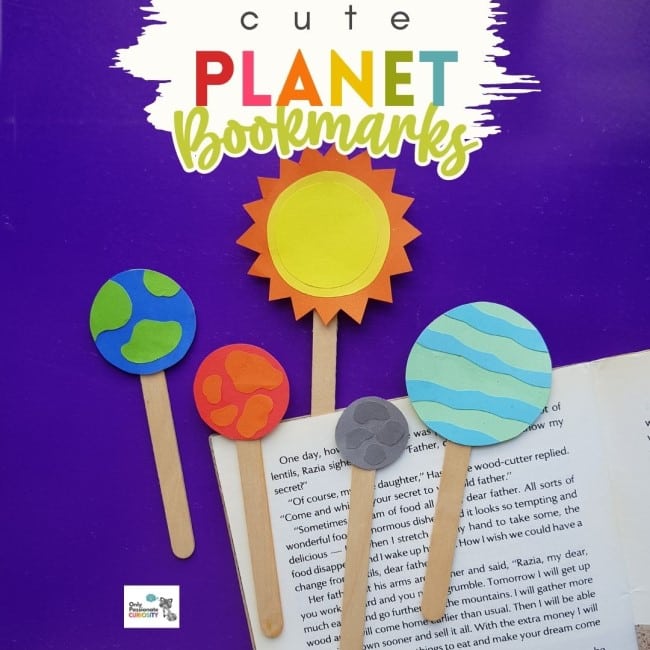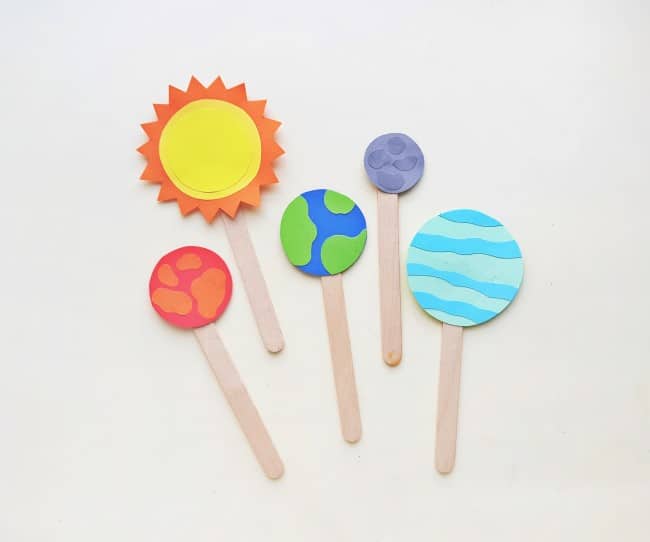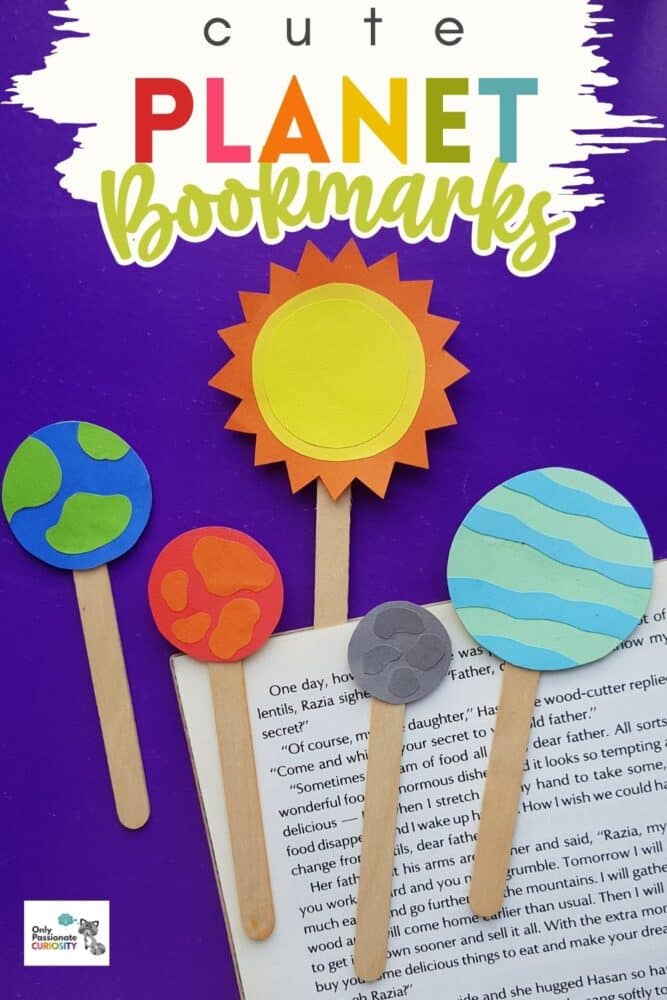Cute Planet Bookmarks
If you’re looking for a fun and easy craft project that’s out of this world, why not try making planet bookmarks with your child? These unique and colorful bookmarks are not only functional, but they also add a touch of cosmic charm to your reading material.
In this blog post, we’ll show you step-by-step instructions with accompanying photos on how to make your own planet bookmarks using simple materials. But first, let’s look at some fun facts about our solar system!

Fun Facts about the Planets
Here are some interesting fun facts about the planet in our solar system:
Mercury is the smallest planet in our solar system. It is also the closest planet to the Sun. Mercury is a rocky planet filled with craters. It orbits the Sun every 88 Earth days. Mercury is hot but also has ice.
Venus is the second planet from the Sun. It is the closest planet to Earth and is a little bit smaller than Earth. Venus is the brightest object in the night sky, except for the moon. It is so bright because yellow clouds of sulfuric acid reflect the light from the sun. Even though it is not as close to the Sun as Mercury, Venus is the hottest planet in the solar system. This is because of its thick atmosphere. Its surface contains volcanoes.
Earth is the third planet from the Sun, and it is the planet we live on. Earth is a rocky planet, even though water covers about 70% of Earth’s surface. There are also layers of gases surrounding Earth. This is called the atmosphere, which helps keep the temperatures on Earth just right for humans to survive. Earth completes one orbit around the Sun in 365 days.
Mars, the fourth planet from the Sun, is the second smallest planet in the solar system. It is about half the size of Earth and is sometimes called the “Red Planet” because … you guessed it! It’s red. Mars is a rocky planet with mountains and volcanoes, including a volcano called “Olympus Mons,” which is the largest volcano in our solar system. It also has two small moons.
Jupiter is the fifth planet from the Sun. It is the largest planet in the solar system. It is called a gas giant because it is actually made of gases, primarily hydrogen and helium. This means that the planet does not have a solid surface like Earth, Mars, Venus, or Mercury. Jupiter can also be seen from Earth at night and is the second brightest planet, after Venus. Jupiter has a spot called “The Great Red Spot” which is a big, swirling storm three times the size of Earth. If you made one of your planet bookmarks like Jupiter, it probably wouldn’t fit into a book!
Saturn, the sixth planet from the Sun, is the second largest planet in our solar system. Only Jupiter is larger. Saturn is also a giant gas planet made up of mostly hydrogen and helium. Saturn is known for the rings surrounding it, which can be seen from Earth with a telescope. Saturn also has 82 moons.
Uranus is the seventh planet from the Sun, and the third largest planet in the solar system. It is another one of the gas giants, meaning it does not have a solid surface. Uranus is the coldest planet in the solar system. It is a pretty color due to a gas called methane, which makes it bright blue. Uranus has 27 moons, and it also has 13 rings, but they are not as bright as the rings surrounding Saturn.
Neptune is the eighth planet in our solar system and the farthest from the Sun. It is the last of the gas giants and the smallest of the giant gas planets as well. Neptune is a lot like Uranus in size and mass. They are sometimes called twin planets. Neptune is dark and stormy with a thick and windy atmosphere. Neptune has 14 moons and six small, narrow rings. Neptune is a blue planet.
Dwarf planets are like the eight main planets that orbit the sun, but smaller (not as small as your planet bookmarks, though). We have five dwarf planets in the solar system that we know of. Their names are Pluto, Eris, Ceres, Makemake, and Haumea. There may be more dwarf planets that we have not yet discovered.
Pluto is the largest dwarf planet. For a long time, it was considered the ninth planet in the solar system, but it is now called a dwarf planet instead. Pluto is smaller than Earth’s moon. Its surface consists of rock and frozen gases because it is so far away from the sun. Pluto has five moons. Interestingly, Pluto’s unique orbit sometimes brings it closer to the sun than the planet Neptune.
Okay, let’s jump into the planet bookmarks now!
List of Supplies for Planet Bookmarks

- Colored craft papers
- Popsicle sticks
- Glue
- Pencil
- Scissors
- Planet Template #1 (opens in new window)
- Planet Template #2 (opens in new window)
Instructions for Planet Bookmarks
Step 1:
Select different colored craft papers for the planet bookmarks. Let’s start our craft with the sun and planet Earth. Select yellow and orange craft paper for the sun, and select blue and green craft paper for the planet Earth craft.
Trace the base of the sun on orange paper and trace the base of the earth on blue paper. Then trace the other patterns of the sun on yellow paper and the earth patterns on green paper.

Step 2:
Take the big circle pattern of the sun and glue it to the center of the orange base.

Step 3:
Take the small circle cutout of the sun and attach it to the center of the big one.

Step 4:
Now, you’ll need to take the green cutout of the earth patterns and glue them onto the round blue base prepared for the planet Earth craft.

Step 5:
Finally, glue the sun and planet Earth onto popsicle sticks to complete your planet bookmarks.

Step 6:
Use the template and follow the steps above to craft the rest of the planets.

Whether you’re an avid reader or just looking for a fun DIY project, making planet bookmarks is a great way to express your creativity and add a little bit of outer space to your day.
Additional Activities:
- Are you looking to make more out-of-this-world bookmarks? Add this rocket bookmark to your list!
- If you’re doing a homeschool unit on space and looking for a way to help your child learn some facts about the planets in our solar system, check out this printable activity.
- Do you have younger children in your homeschool? This is a fun and easy solar system activity for little learners.
- Older students will love these hands-on Mission to Mars activities!
- Another fun and creative project for older students is this painting stars activity.
- Or try these free astronaut and rocket ship lessons for kids of all ages.
- You can use this 20-page digital download about planets to teach your child about the solar system. This packet covers all the planets, including Pluto and the dwarf planets, as well as the sun, moon, comets, and more.
- Check out this comprehensive list of ideas, resources, and activities on the theme of space, planets, and stars.











